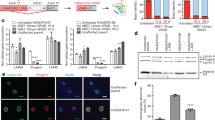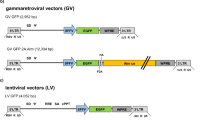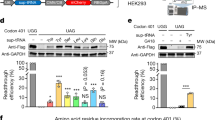Abstract
The woodchuck hepatitis virus posttranscriptional regulatory element (WPRE) is widely used in retroviral gene transfer vectors. However, this element contains an open-reading frame (ORF) encoding a truncated peptide of the woodchuck hepatitis virus X protein (WHX). Because we are developing a lentiviral vector for the gene therapy of Wiskott–Aldrich syndrome (WAS), we evaluated whether the WPRE was needed in the gene transfer cassette and tested the possibility of replacing it with a mutated derivative. The transcriptional activity of the WPRE was undetectable in the context of the lentiviral vector but the element was capable of translating a polypeptide. This capability was abrogated by mutating the WHX ORF translation start. The WPRE was required to express high levels of the transgene and for that, the native form or mutated derivatives functioned equivalently. The vector using a WAS gene promoter and the mut6 WPRE induced long-term expression of the WAS transgene in vivo, correcting cytoskeletal defects, thymocyte and B-cell numbers and improved the colitis of WAS-null mice. By providing additional evidence of efficacy of this WAS lentiviral vector with improved safety features, our results validate a mutated WPRE, which should be useful in future gene therapy applications.
This is a preview of subscription content, access via your institution
Access options
Subscribe to this journal
Receive 12 print issues and online access
$259.00 per year
only $21.58 per issue
Buy this article
- Purchase on Springer Link
- Instant access to full article PDF
Prices may be subject to local taxes which are calculated during checkout






Similar content being viewed by others
Accession codes
References
Donello JE, Loeb JE, Hope TJ . Woodchuck hepatitis virus contains a tripartite posttranscriptional regulatory element. J Virol 1998; 72: 5085–5092.
Zufferey R, Donello JE, Trono D, Hope TJ . Woodchuck hepatitis virus posttranscriptional regulatory element enhances expression of transgenes delivered by retroviral vectors. J Virol 1999; 73: 2886–2892.
Schambach A, Wodrich H, Hildinger M, Bohne J, Krausslich HG, Baum C . Context dependence of different modules for posttranscriptional enhancement of gene expression from retroviral vectors. Mol Ther 2000; 2: 435–445.
Salmon P, Kindler V, Ducrey O, Chapuis B, Zubler RH, Trono D . High-level transgene expression in human hematopoietic progenitors and differentiated blood lineages after transduction with improved lentiviral vectors. Blood 2000; 96: 3392–3398.
Callendret B, Lorin V, Charneau P, Marianneau P, Contamin H, Betton JM et al. Heterologous viral RNA export elements improve expression of severe acute respiratory syndrome (SARS) coronavirus spike protein and protective efficacy of DNA vaccines against SARS. Virology 2007; 363: 288–302.
Higashimoto T, Urbinati F, Perumbeti A, Jiang G, Zarzuela A, Chang LJ et al. The woodchuck hepatitis virus post-transcriptional regulatory element reduces readthrough transcription from retroviral vectors. Gene Therapy 2007; 14: 1298–1304.
Popa I, Harris ME, Donello JE, Hope TJ . CRM1-dependent function of a cis-acting RNA export element. Mol Cell Biol 2002; 22: 2057–2067.
Schambach A, Galla M, Maetzig T, Loew R, Baum C . Improving transcriptional termination of self-inactivating gamma-retroviral and lentiviral vectors. Mol Ther 2007; 15: 1167–1173.
Charrier S, Dupre L, Scaramuzza S, Jeanson-Leh L, Blundell MP, Danos O et al. Lentiviral vectors targeting WASp expression to hematopoietic cells, efficiently transduce and correct cells from WAS patients. Gene Therapy 2007; 14: 415–428.
Dupre L, Marangoni F, Scaramuzza S, Trifari S, Hernandez RJ, Aiuti A et al. Efficacy of gene therapy for Wiskott–Aldrich syndrome using a WAS promoter/cDNA-containing lentiviral vector and nonlethal irradiation. Hum Gene Ther 2006; 17: 303–313.
Kingsman SM, Mitrophanous K, Olsen JC . Potential oncogene activity of the woodchuck hepatitis post-transcriptional regulatory element (WPRE). Gene Therapy 2005; 12: 3–4.
Wei Y, Etiemble J, Fourel G, Vitvitski-Trepo L, Buendia MA . Hepadna virus integration generates virus-cell cotranscripts carrying 3′ truncated X genes in human and woodchuck liver tumors. J Med Virol 1995; 45: 82–90.
Tu H, Bonura C, Giannini C, Mouly H, Soussan P, Kew M et al. Biological impact of natural COOH-terminal deletions of hepatitis B virus X protein in hepatocellular carcinoma tissues. Cancer Res 2001; 61: 7803–7810.
Themis M, Waddington SN, Schmidt M, von Kalle C, Wang Y, Al-Allaf F et al. Oncogenesis following delivery of a nonprimate lentiviral gene therapy vector to fetal and neonatal mice. Mol Ther 2005; 12: 763–771.
Gaspar HB, Bjorkegren E, Parsley K, Gilmour KC, King D, Sinclair J et al. Successful reconstitution of immunity in ADA-SCID by stem cell gene therapy following cessation of PEG-ADA and use of mild preconditioning. Mol Ther 2006; 14: 505–513.
Charrier S, Stockholm D, Seye K, Opolon P, Taveau M, Gross DA et al. A lentiviral vector encoding the human Wiskott–Aldrich syndrome protein corrects immune and cytoskeletal defects in WASP knockout mice. Gene Therapy 2005; 12: 597–606.
Calle Y, Chou HC, Thrasher AJ, Jones GE . Wiskott–Aldrich syndrome protein and the cytoskeletal dynamics of dendritic cells. J Pathol 2004; 204: 460–469.
Westerberg L, Larsson M, Hardy SJ, Fernandez C, Thrasher AJ, Severinson E . Wiskott–Aldrich syndrome protein deficiency leads to reduced B-cell adhesion, migration, and homing, and a delayed humoral immune response. Blood 2005; 105: 1144–1152.
Snapper SB, Rosen FS, Mizoguchi E, Cohen P, Khan W, Liu CH et al. Wiskott–Aldrich syndrome protein-deficient mice reveal a role for WASP in T but not B cell activation. Immunity 1998; 9: 81–91.
Nguyen DD, Maillard MH, Cotta-de-Almeida V, Mizoguchi E, Klein C, Fuss I et al. Lymphocyte-dependent and Th2 cytokine-associated colitis in mice deficient in Wiskott–Aldrich syndrome protein. Gastroenterology 2007; 133: 1188–1197.
Schambach A, Bohne J, Baum C, Hermann FG, Egerer L, von Laer D et al. Woodchuck hepatitis virus post-transcriptional regulatory element deleted from X protein and promoter sequences enhances retroviral vector titer and expression. Gene Therapy 2006; 13: 641–645.
Zychlinski D, Schambach A, Modlich U, Maetzig T, Meyer J, Grassman E et al. Physiological promoters reduce the genotoxic risk of integrating gene vectors. Mol Ther 2008; 16: 718–725.
Maillard MH, Cotta-de-Almeida V, Takeshima F, Nguyen DD, Michetti P, Nagler C et al. The Wiskott–Aldrich syndrome protein is required for the function of CD4(+)CD25(+)Foxp3(+) regulatory T cells. J Exp Med 2007; 204: 381–391.
Klein C, Nguyen D, Liu CH, Mizoguchi A, Bhan AK, Miki H et al. Gene therapy for Wiskott–Aldrich syndrome: rescue of T-cell signaling and amelioration of colitis upon transplantation of retrovirally transduced hematopoietic stem cells in mice. Blood 2003; 101: 2159–2166.
Meyer-Bahlburg A, Becker-Herman S, Humblet-Baron S, Khim S, Weber M, Bouma G et al. Wiskott–Aldrich syndrome protein deficiency in B cells results in impaired peripheral homeostasis. Blood 2008; 112: 4158–4169.
Montini E, Cesana D, Schmidt M, Sanvito F, Ponzoni M, Bartholomae C et al. Hematopoietic stem cell gene transfer in a tumor-prone mouse model uncovers low genotoxicity of lentiviral vector integration. Nat Biotechnol 2006; 24: 687–696.
Marangoni F, Bosticardo M, Charrier S, Draghici E, Locci M, Scaramuzza S et al. Evidence for long-term efficacy and safety of gene therapy for Wiskott–Aldrich Syndrome in preclinical models. Mol Ther 2009 (in press).
Zufferey R, Nagy D, Mandel RJ, Naldini L, Trono D . Multiply attenuated lentiviral vector achieves efficient gene delivery in vivo. Nat Biotechnol 1997; 15: 871–875.
Towers GJ, Stockholm D, Labrousse-Najburg V, Carlier F, Danos O, Pages JC . One step screening of retroviral producer clones by real time quantitative PCR. J Gene Med 1999; 1: 352–359.
Acknowledgements
We are grateful for excellent technical help from Genethon colleagues, notably Khalil Seye for the qPCR assays, Johanna Blondeau for western blots, Anne Samba for virus stock production, Bernard Gjata for histology, Séverine Charles for bioexperimentation and the zootechnicians for animal care. We also thank MG Roncarolo and Dr L Naldini (Tiget, Milan) for providing the initial lentiviral plasmids. The work was supported in part from funds from the FP6 CONSERT European project (FP6-2003-LIFESCIHEALTH-I-005242) and from AFM (French Muscular Dystrophy Association). AJT was supported by the Wellcome Trust.
Author information
Authors and Affiliations
Corresponding author
Additional information
This work was performed at Généthon, 1 bis, rue de l'Internationale, 91002 Evry, France.
Supplementary Information accompanies the paper on Gene Therapy website (http://www.nature.com/gt)
Supplementary information
Rights and permissions
About this article
Cite this article
Zanta-Boussif, M., Charrier, S., Brice-Ouzet, A. et al. Validation of a mutated PRE sequence allowing high and sustained transgene expression while abrogating WHV-X protein synthesis: application to the gene therapy of WAS. Gene Ther 16, 605–619 (2009). https://doi.org/10.1038/gt.2009.3
Received:
Revised:
Accepted:
Published:
Issue Date:
DOI: https://doi.org/10.1038/gt.2009.3



